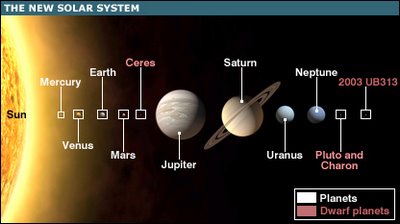12 planets not 9!!!

About 2,500 scientists meeting in
The researchers said Pluto failed to dominate its orbit around the Sun in the same way as the other planets.
The International Astronomical Union's (IAU) decision means textbooks will now have to describe a Solar System with just eight major planetary bodies.
Pluto, which was discovered in 1930 by the American Clyde Tombaugh, will be referred to as a "dwarf planet".
There is a recognition that the demotion is likely to upset the public, who have become accustomed to a particular view of the Solar System.
Without a new nomenclature, these discoveries raised the prospect that textbooks could soon be talking about 50 or more planets in the Solar System.
Amid dramatic scenes in the Czech capital which saw astronomers waving yellow ballot papers in the air, the IAU voted to block this possibility - and in the process took the historic decision to relegate Pluto.
The scientists agreed that for a celestial body to qualify as a planet:
- It must be in orbit around the Sun.
- It must be large enough that it takes on a nearly round shape.
- It has cleared its orbit of other objects.
Pluto's status has been contested for many years. It is further away and considerably smaller than the eight other "traditional" planets in our Solar System. At just 2,360km (1,467 miles) across, Pluto is smaller even than some moons in the Solar System.
In addition, since the early 1990s, astronomers have found several objects of comparable size to Pluto in an outer region of the Solar System called the Kuiper Belt.
Some astronomers have long argued that Pluto would be better categorized alongside this population of small, icy worlds.
The critical blow for Pluto came with the discovery three years ago of an object currently designated 2003 UB313 (sedna). After being measured with the Hubble Space Telescope, it was shown to be some 3,000km (1,864 miles) in diameter: it is bigger than Pluto.
2003 UB313 (Sedna) will now join Pluto in the dwarf category, along with Pluto's major moon Charon, and the biggest asteroid in the Solar System Ceres.
An US spacecraft called New Horizons is due to fly by Pluto and the Kuiper belt in 2015.




8 Comments:
I read about this in the news but I didn't know they were considering the dwarf planets .. interesting
Well... at first they didn’t want to make a new category called (dwarf planets), but after that when they announced the definition of a planet they disqualified Pluto and made the new category.
Fauzan: you can call pluto a Dwarf planet ^__^
mashala ur parents must be really proud of you :) you are amazing mashala. god bless you o y7afthek enshala. you're in a private school right?
Anonymous: Thank you and no im not in a private school. I’m in a 7okoma school ^___*
oh reallly? but ur english mashala is very fluent. alah y7afthek lahlek enshala :) keep it up ok young man? wish you all the luck in ur life :>
Thanks anonymous ^___*
2003 UB313 is Eris, not Sedna. 2003 VB12 was the designation for 90377 Sedna.
Post a Comment
<< Home